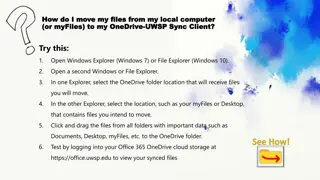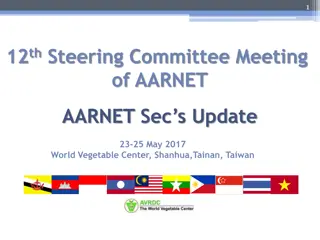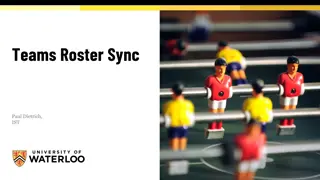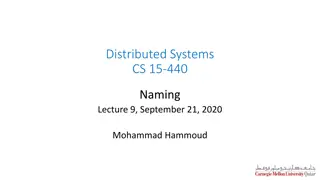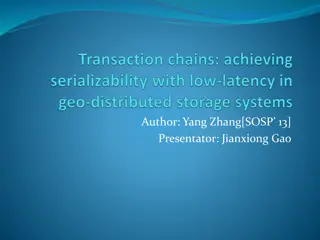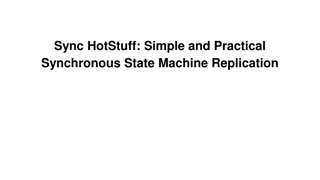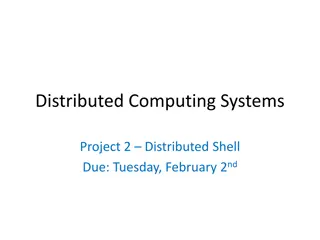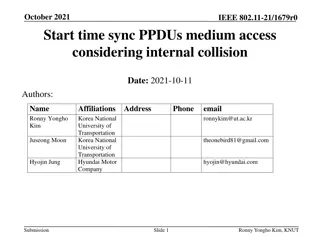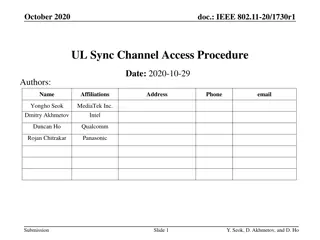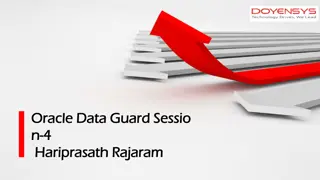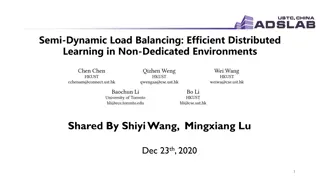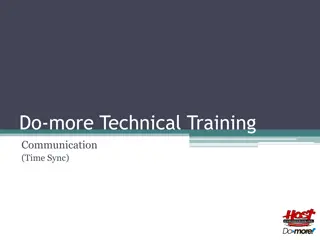Distributed Sync & Share Operations at AARNet - January 2016
A summary of the distributed sync and share operations at AARNet as of January 2016, covering topics such as Australian population density, CloudStor services, database load balancing, and storage upgrades. The slides detail the infrastructure, services provided, user statistics, and upcoming expansions of the network. Explore the advancements made in data management, network security, and technology integration within the AARNet ecosystem.
Download Presentation

Please find below an Image/Link to download the presentation.
The content on the website is provided AS IS for your information and personal use only. It may not be sold, licensed, or shared on other websites without obtaining consent from the author.If you encounter any issues during the download, it is possible that the publisher has removed the file from their server.
You are allowed to download the files provided on this website for personal or commercial use, subject to the condition that they are used lawfully. All files are the property of their respective owners.
The content on the website is provided AS IS for your information and personal use only. It may not be sold, licensed, or shared on other websites without obtaining consent from the author.
E N D
Presentation Transcript
Analysis of Programming Languages Lembit J rim gi lembit.jyrimagi@gmail.com, Vladimir Viies vladimir.viies@gmail.com Tallinna Tehnika likool 2021
Subject goals A student has to be able: to associate tasks with a suitable algorithmic language; to design a special purpose algorithmic language and create a compiler for it; 3
Subject contents I Classification of algorithmic languages. Universal and specific languages. Comparison of the possibilities of data types, sentences and intramodular data exchange in different languages (FORTRAN ,C, PL/1, Java,PASCAL, Assembler etc.). Assembler. Translators, their components and work principles. Art of translator design. 4
POINTS I(EXAM) practice Tasks homework(inc.seminar) written examination 5
Points II(EXAM & PERMISSION) Practice(T1+T2) max20p Homework (translator) max20p Presentation (languages) max10p Written examination Permission to examination(35p) min 15lab(max30) + min 20test (max 30) max50p 6
Course structure I module: Practice(translator design) II module: Seminars (Comparison of the possibilities in different languages) III module:Homeworks 7
Course timetable 1. 2. 3. 4. 5. 6. 7. 8. 9. 10. 11. 12. 13. 14. 15. 16. 30.08.2021 06.09.2021 13.09.2021 20.09.2021 27.09.2021 04.10.2021 11.10.2021 18.10.2021 25.10.2019 01.11.2021 08.11.2021 15.11.2021 22.11.2021 29.11.2021 06.12.2021 13.12.2021 Introduction Regular Languages, Regular Expressions, Flex Evolution of Programming Languages Context Free Grammar, Bison, Postfix/Infix Calculator Practice Task 1 Abstract Syntax Tree, General Purpose Language Functional Language, part 1 Functional Language, part 2 Guest lecturer Guest lecturer Test Machine Language, Assembly Language Practice Task 2 Presentation Presentation Exam 8
Subject contents II LET'S BUILD A COMPILER! By Jack W. Crenshaw, Ph.D. This file contains all of the installments of Jack Crenshaw's tutorial on compiler construction. The intended audience is those folks who are not computer scientists, but who enjoy computing and have always wanted to know how compilers work. A lot of compiler theory has been left out, but the practical issues are covered. By the time you have completed the series, you should be able to design and build your own working compiler. It will not be the world's best, nor will it put out incredibly tight code. Your product will probably never put Borland or MicroSoft out of business. But it will work, and it will be yours 9
Presentation (analysis question list) (analyze different languages) - field where language is used (general purpose hardware, gpu, vm, web etc), proximity to hardware(What problem is language meant to solve?)... - compiled or interpreted, comparative speed to other languages... - strongly typed vs weakly typed, examples, data type conversion? - single thread vs multithread, handling of parallelism, examples... - memory handling, explicit memory allocation vs implicit, examples... - what sort of problems would you use this language for? - if you could improve on this language what would you add to it or remove from it? - extending the functionality of language, dlls, apis... - is the purpose of the code understandable when looking at code (assembler - no, pascal - somewhat, scripting languages yes)... - effort needed for learning the language (assembler - high, scripts medium) - an example program in the language from the field it is used for.. 10
COMPUTER as a MULTILEVEL MACHINE Each level supported by the level below it: level 5 problem oriented language translated by compiler level 4 assembly language level translated by assembly level 3 operating system partial interpretation by OS level 2 conventional machine language interpreted by micro-program level 1 micro-programming directly executed by hardware level 0 digital logic gates & transistors, 12
SQL Translator Make up a language for specific area or task of your choice. An example and a possible choice is a language for managing library. Create a SQL translator using GNU Bison (or any alternative) to translate your made up language to SQL. Write a simple database interface for executing the translated SQL queries in a database. Set up a simple database to demostrate inserting and quering data in the made up language
TRANSLATION VS. INTERPRETATION I Translation: program written for level n machine translated to level 1 machine Advantages: statements decoded ONCE efficient execution Disadvantages: space consumption Interpretation: program written for level n + 1 is executed on level n machine Advantages: space conservation Disadvantages: execution speed 14
TRANSLATION VS. INTERPRETATION II TRANSLATORS Compiler: high level-> machine Assembler: one to one, assembly -> machine Loader: relocatable version of machine code -> machine code Link editor: combines collections of relocatable programs -> single relocatable machine program Pre-processor: extended language -> standard language 15
TRANSLATION VS. INTERPRETATION III INTERPRETER Fetch op code De-code op code Fetch necessary operands Branch to primitive (OPk) Then repeat until the end of the program 16
Significant Language Features I Simple to learn Machine Independent More natural ways to express mathematical functions Problem orientated language Remains close to and exploits the available hardware Efficient execution Ability to control storage allocation More freedom in code layout 18
Significant Language Features II Loops Input from the keyboard Menu Driven Applications System Commands Structured Programming Subroutines Built-In Functions User-Defined Functions Arrays, sorting, and searches 19
Significant Language Features III Criteria for Language Design Evaluation 1. efficiency (translation and execution) 2. simplicity (readability and writability) 3. orthogonality 4. definiteness (syntax and semantics) 5. reliability 6. program verification (correctness) 7. abstraction facilities (data and procedural) 8. portability 20
What is an "Algol-like" language? Algorithmic language for describing Processes Imperative (most computation work done in assignment statements) Block & procedure Lexical scope C Algol lexical scope 21
PSEUDO LANGUAGE I LANGUAGE ARE ALLOWED TO USE THE FOLLOWING SENTENCES: assigment binary unary x = y; x = x y; x = x; x = x + 1 x = succ(x) x = x - 1 x = pred(x) simplification 22
PSEUDO LANGUAGE II GOTO M BR M JMP M IF x y THEN GOTO M x,y {A} A- set of integers CMP x,y Bii M ii (NE, EQ, GT, LT, GE, LE) CMPB X,Y X,Y {C} C- set of alphabetical symbols Bcc M cc (NE, EQ, ..........) special functionality 23
PSEUDO LANGUAGE III If you compare the form of the IF statement above with the assembler code that must be produced, you can see that there are certain actions associated with each of the keywords in the statement: IF: First, get the condition and issue the code for it. Then, create a unique label and emit a branch if false. ENDIF: Emit the label. These actions can be shown very concisely if we write the syntax this way: IF <condition> { Condition; L = NewLabel; Emit(Branch False to L); } <block> ENDIF { PostLabel(L) } 24
PSEUDO LANGUAGE IV EXAMPLE 1(Pascal) IF ( condition) THEN sentence1; ELSE sentence2; if then : sentence1; goto endif; else : sentence2; endif : program will continue : if !(condition) then goto else; 25
PSEUDO LANGUAGE V EXAMPLE 2(C) DO {sentence1; sentence2; .... sentenceN;} WHILE expression; do : sentence1; sentence2; ... sentenceN; check : calculation of expression; while : if not expression goto do; 26
If-then/else or case design issues What type of selector expression? What types of case labels? Can you branch to case labels from outside? Mutually exclusive labels? Exhaustive label case coverage? 27
Loop design issues What type of values may loop variable assume? Complexity of loop expression? How often is loop variable checked against final value? Can loop variable be assignment inside loop body? When evaluate stopping expression? Transfer permitted outside loop? Scope of loop variable? 28
Exercise 1 Your assignment are to select 3 of the languages (set of languages) and evaluate its standard implementation. You are to assign the language a grade (1 through 5) for each criterion point listed below and to provide written justification for your rating. This set of languages is to include at least the following: Fortran, Cobol, PL/I, Pascal, C, C++, Ada, Lisp, Smalltalk, Basic, Modula-2, Algol, APL, Snobol, Icon, Prolog, Simula, Scheme, Eifel, Oberon, Visual Basic, Visual C++, Perl, Java, Delphi, HTML 29
Excercise 2 LOOP: DO WHILE (FLAG = 0); PUT SKIP DATA('HELLO WORLD!'); END LOOP; END HELLO; ******Ouput for Hello World WRITE(6,*)'Hello world' STOP END class HelloWorld { public static void main(String args[]) { System.out.println("Hello world!"); }} #include<stdio.h> main() { printf("Hello World"); } 30
Excercise 3 What language(s) was describe with below characteristics : - data types, data objects, and procedure specifications can be encapsulated into a package. This supports the program design of data abstraction. - has very good exception handling capabilities which allow the program to handle its own run- time errors. - it is possible to write a procedure (for example, a sorting procedure) which does not require a data type to be specified. - supports parallel and concurrent execution of tasks. - support for object-oriented programming - more flexible libraries - better control mechanisms for shared data 31
Test task example Write an interpreter for the calculator language defined below. You may assume that there are no operator precedence rules if you wish. expression::= operand [ operator operand]. operand ::= 0 | 1 | 2 | 3 | 4 | 5 | 6 | 7 | 8 | 9 operator ::= + | - | * | / You may use any language you wish to do this. You will need to turn in a clearly commented source listing of your program. 32




